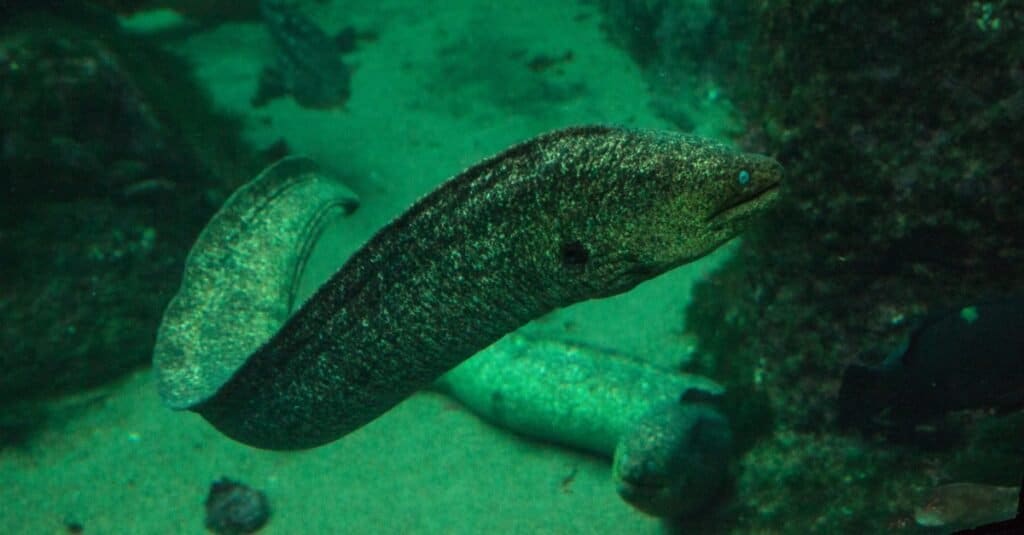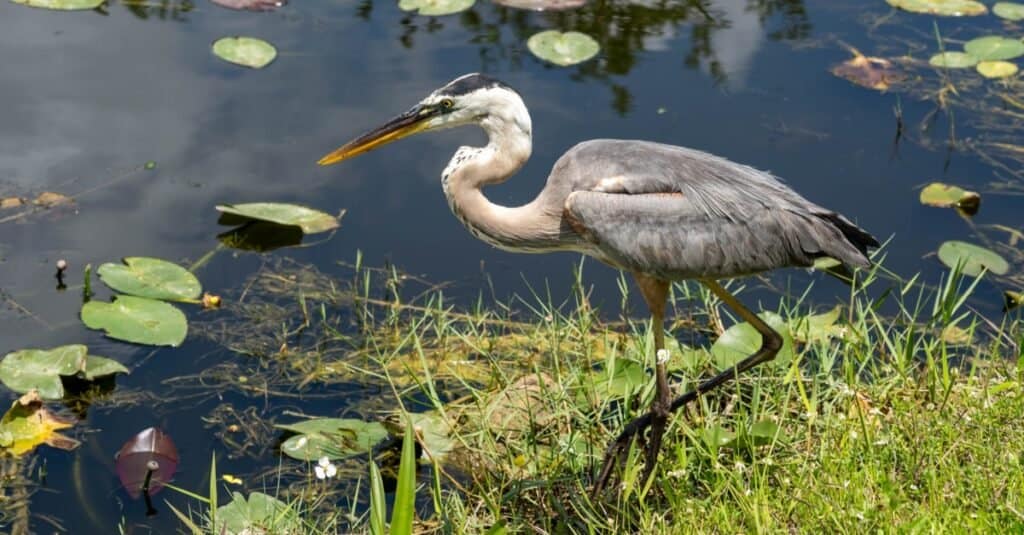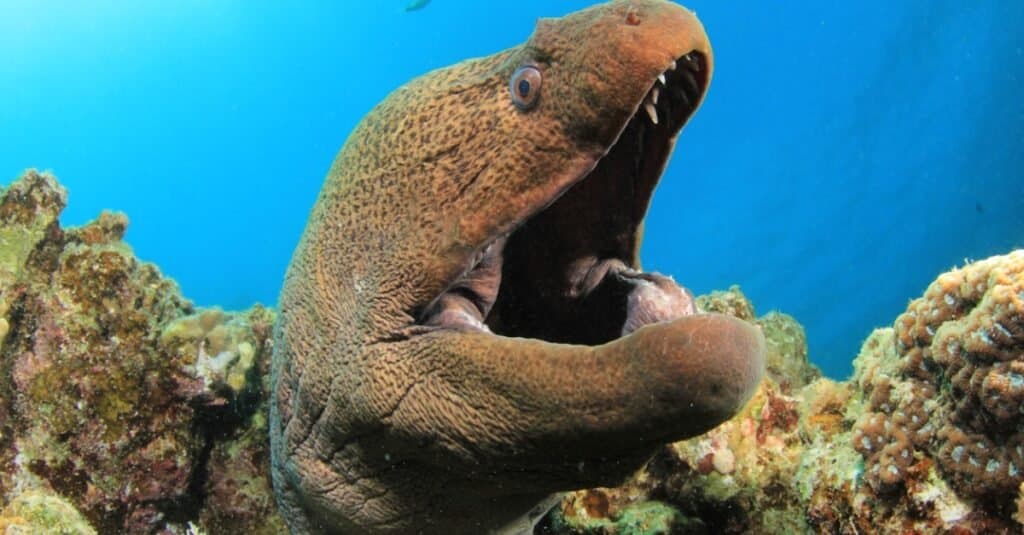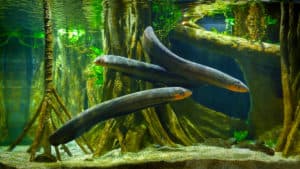Eels are fearsome ray-finned fish resembling snakes that live both in saltwater and freshwater. These fish live in waters all around the world, putting them in close quarters with many other sea creatures. With their scary looks and sharp teeth, it’s common for someone to ask, what do eels eat?
A quick look at the eels’ diet, their hunting habits, and their predators provides a solid foundation of understanding about these creatures. In some cases, they’re rather frightening creatures and in others, they’re almost sympathetic.
What Foods Do Eels Eat?

Eels eat insects, fish, and crustaceans as part of their carnivorous diet.
©SunflowerMomma/Shutterstock.com
Eels eat fish, crustaceans, and mollusks. They are carnivorous predators that eat a very diverse diet, including just about any marine creature that is smaller than them. Eels are great hunters, but they are also wise enough to avoid creatures that can do them harm.
Here is a list of the creatures that eels will consume most frequently:
- Sea urchins
- Crabs
- Shrimp
- Lobsters
- Frogs
- Krill
- Worms
- Clams
- Barnacles
- Woodlice
- Crayfish
- Plankton
- Mussels
- Squid
- Octopus
- Crickets
- Jellyfish
- Mosquitos
- Eels
- Various carrion in freshwater
Eels eat a wide variety of foods, but their diets are slightly different when they are in freshwater versus when they’re in saltwater. In particular, they will have access to more insects when they are in freshwater areas, but eels can hunt more diverse marine animals when they’re in the saltwater.
Baby eels, also called elvers, spend the first weeks of their lives consuming a variety of foods based on where they live. In freshwater, they will mostly consume insects and very small fish. However, at sea, they will be somewhat herbivorous, feeding upon plankton until they’re large enough to consume an adult diet owing to the lack of access to insects.
Eels consume many foods, surviving as effective predators no matter where they live. Also, they tend to eat various amounts given their area. For example, pet freshwater eels are usually fed about once per day, but saltwater eels only get fed about 3-4 times per week. The latter eel’s diet is richer and more nutritious, though.
In the wild, eels hunt as they need, and they are capable of going several weeks without eating if food is scarce.
How Do Eels Hunt?

Moray eels skim along reefs to find prey.
Eels are cunning creatures that rely on their swift swimming and thin profile to sneak up on prey. For the most part, eels hunt at night, using the low visibility to their advantage to find prey. After all, they have poor eyesight, but they make up for that with a powerful sense of smell.
Most often, eels will hunt near the area they live. Often, eels will dwell near the bottom of a body of water or in rocky outcroppings, waiting for something to come by that they can eat. They will only try to attack smaller prey for fear they could get hurt.
Eels will also cruise along reefs to find prey, using a mucous coating to allow them to slide through small gaps without getting scraped or cut. Interestingly, eels do not always hunt alone. Specifically, the moray eels have been found hunting in groups with one another to viciously attack predators with their powerful bites. Often, moray eels will wrap their bodies around their prey to trap them and then eat them whole.
Moray eels can also hunt with other fish, like groupers. This is a rare occasion of two fish cooperating in a hunt. The moray eel is capable of chasing fish out of smaller areas that the grouper can’t reach, and the grouper can also frighten prey into the waiting jaws of the eel. This highly unusual hunting system is the subject of many studies and is even more intriguing when one considers that the grouper is a predator of small moray eels!
What Predators Eat Eels?

Herons are predators for freshwater eels.
©ttomasek15/Shutterstock.com
Eels in freshwater and saltwater face a variety of predators. Their predators tend to be larger or more cunning sea creatures as well as a few outliers. We’re going to combine the list of eel predators to include both freshwater and saltwater threats, which include:
Each of these creatures poses a threat to eels in the wild. Human beings are very common predators of eels, using them as ingredients in dishes.
In fact, entire farming operations have been established to raise eels so they can be fattened up, slaughtered, and sent to the restaurants where they will be served in a variety of dishes. Places like Japan are famous for using eel in their foods, but eel is starting to catch on in other places, too.
In that sense, humans are the deadliest predators for eels overall.
Are Eels Dangerous to People?

Moray eels can take a bite from humans.
©Rich Carey/Shutterstock.com
As with many strong predators, people will always wonder if certain animals pose a threat to them. In the case of eels, some species can be dangerous. However, eels do not like to attack bigger creatures than them. On most of the occasions when people have been hurt by eels, it’s because they got too close to the fish for their own good.
Stories have emerged of people having digits bitten off by moray eels while trying to feed them or getting an infected bite from them while swimming. Given the strength of an eel’s bite and a human’s instinct to pull away once bitten, it’s no wonder the eel’s bite often causes more damage to their soft tissue.
Electric eels, while not truly eels, can also be dangerous if bothered. Their shock can directly result in death in rare cases, but a mild shock can cause someone underwater to have difficulty surfacing and drown. In short, leave wild animals alone and it’s highly unlikely that you’ll be attacked.
Eels prefer to eat smaller fish, crustaceans, and insects depending on where they live. Eels might look like fierce creatures, but they do not feed all that much or attack humans on sight. Some people farm eels for food and others keep them as pets. These ray-finned fish are interesting, intelligent, and highly capable hunters.
The photo featured at the top of this post is © Natursports/Shutterstock.com
Thank you for reading! Have some feedback for us? Contact the AZ Animals editorial team.





